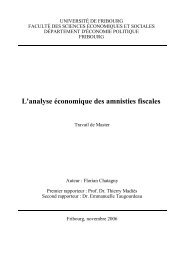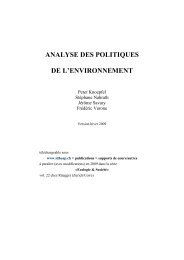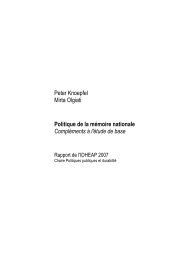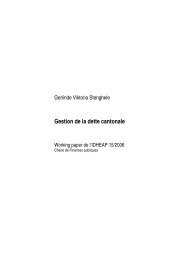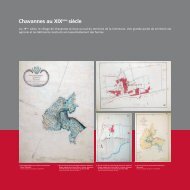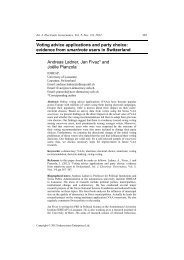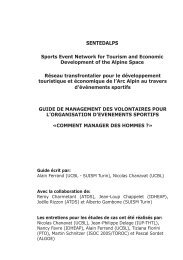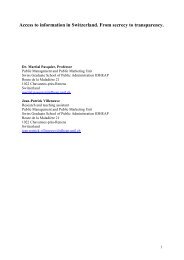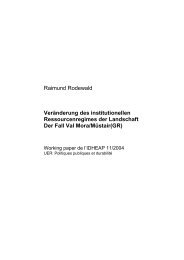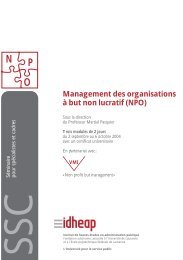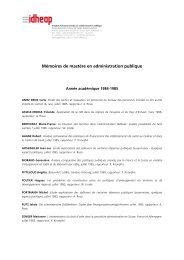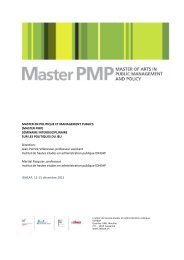Historical Analysis of Institutional Regimes in Switzerland ... - IDHEAP
Historical Analysis of Institutional Regimes in Switzerland ... - IDHEAP
Historical Analysis of Institutional Regimes in Switzerland ... - IDHEAP
Create successful ePaper yourself
Turn your PDF publications into a flip-book with our unique Google optimized e-Paper software.
8<br />
goods and services is required. We refer here to <strong>Institutional</strong> Resource <strong>Regimes</strong> (IR) for the use <strong>of</strong><br />
natural resources which promote susta<strong>in</strong>ability.<br />
Before present<strong>in</strong>g the analytical concept (4.1) and the IR typology and development trajectories (4.2<br />
and 4.3), we would first like to briefly def<strong>in</strong>e what should be understood by the term <strong>in</strong>stitution.<br />
Institutions are usually understood as a set <strong>of</strong> rules which structure the relationship between<br />
<strong>in</strong>dividuals by determ<strong>in</strong><strong>in</strong>g the range <strong>of</strong> possible reactions to certa<strong>in</strong> situations and design<strong>in</strong>g the<br />
relationships between <strong>in</strong>dividuals <strong>in</strong> such a way that the - predictable - outcome is equilibrium. Scott<br />
(1995: 33) states <strong>in</strong> this context that "Institutions consist <strong>of</strong> cognitive, normative, regulative structures<br />
and activities that provide stability and mean<strong>in</strong>g to social behaviour." Thus, as a concept “<strong>in</strong>stitution”<br />
is highly equivocal: <strong>in</strong>stitutions can refer to formal rules, behavioural standards, economic and political<br />
structures or framework conditions. For our purposes, the focus is ma<strong>in</strong>ly on the formal rules, i.e. we<br />
are <strong>in</strong>terested <strong>in</strong> their def<strong>in</strong>ition, monitor<strong>in</strong>g, implementation, change and evaluation.<br />
Institutions are both the result <strong>of</strong> past actions and the framework with<strong>in</strong> which their new activities<br />
take place. Institutions and, hence, IRs can change over time and become <strong>in</strong>creas<strong>in</strong>gly differentiated.<br />
Thus, the def<strong>in</strong>ition and classification <strong>of</strong> IRs shall be carried out from a historical perspective. This<br />
requires a comb<strong>in</strong>ed analysis <strong>of</strong> the regulative system (legal distribution <strong>of</strong> ownership and use rights<br />
to the resource) and political factors which are conta<strong>in</strong>ed <strong>in</strong> the resource-specific public policies (e.g.<br />
protection <strong>of</strong> waters, air pollution control). We work on the assumption that - as stated by Scharpf<br />
(1997: 151) - the IR embodies an absolute m<strong>in</strong>imum <strong>in</strong> terms <strong>of</strong> <strong>in</strong>stitutional guidance.<br />
4.1 The analytical concept<br />
Resource policy <strong>in</strong>terventions are comb<strong>in</strong>ed and formed along with (exist<strong>in</strong>g or consciously modified)<br />
property and use rights <strong>in</strong> the process <strong>of</strong> the development <strong>of</strong> the differentiation <strong>of</strong> subsystems and<br />
public policies. We def<strong>in</strong>e an IR as an <strong>in</strong>stitutional framework which comb<strong>in</strong>es the prom<strong>in</strong>ent<br />
programme elements <strong>of</strong> a resource-specific protection and/or use policy (= policy design) with a<br />
specific arrangement <strong>of</strong> the formal property and use rights for the goods and services provided by a<br />
natural resource (= regulative system). While <strong>in</strong> the case <strong>of</strong> the analysis <strong>of</strong> property and use rights, it<br />
is possible to avail <strong>of</strong> the classical research on property-rights regimes undertaken <strong>in</strong> <strong>in</strong>stitutional<br />
economics, the political factors will be exam<strong>in</strong>ed with the help <strong>of</strong> policy (design) analysis. Theoretical<br />
and empirical studies shall therefore concentrate on the identification and changes <strong>in</strong> the central<br />
elements <strong>of</strong> the policy design and <strong>of</strong> the property and use rights. These constitutive elements are<br />
listed <strong>in</strong> Table 1.<br />
Table 1: The central elements <strong>of</strong> an <strong>Institutional</strong> Resource Regime (IR)<br />
Policy Design<br />
Political aims<br />
Instruments<br />
Target groups<br />
<strong>Institutional</strong> (implementation) arrangement<br />
Causal and <strong>in</strong>tervention hypothesis (rationale)<br />
<strong>Institutional</strong> Resource Regime<br />
Property and use rights<br />
Possession <strong>of</strong> title<br />
Organisation <strong>of</strong> exclusion<br />
Access control<br />
Decision-mak<strong>in</strong>g processes <strong>in</strong> the regulative<br />
System



